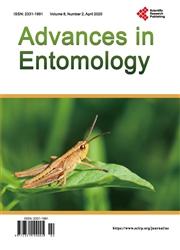Impact of Integrated Pest Management (IPM) Practices on Tomato Cultivation in Gazipur District of Bangladesh
引用次数: 2
Abstract
An experiment was conducted at Nagari union in Kaligonj Upazila of Gazipur district to determine the impact of Integrated Pest Management practices on tomato cultivation. Data were collected by using pre-designed interview schedule from 1st March to 5th August, 2014. The results of the study showed that in the study area farmers cultivated tomato in 14.6% of their land and there are eight IPM practices which are generally used by the farmers in their tomato fields. Regarding the overall adoption of IPM practices in tomato cultivation, 65.0% respondent farmers were in medium to high adoption category. The IPM Practice Use Index (IPUI) was found significantly higher in case of IPM adopters than in case of IPM non-adopters. But “use of pheromone trap”, “setting up the bamboo stick in the field” and “cultivation and use of green manure” were ranked as 1st, 2nd and 3rd, respectively in case of IPM adopters whereas “setting up bamboo stick in field”, “cultivation and using green manure” and “use quality and resistant seeds” obtained 1st, 2nd and 3rd rank, respectively in case of IPM non-adopters. The average infestation of insect and disease was found significantly lower in the fields of IPM adopter (9.7%) than IPM non-adopter (11.8%). The average frequency of chemical use in the season was also significantly lower in the fields of IPM adopter (2.14 times) than IPM non-adopter (3.44 times). The marketable yield was found significantly higher in the fields of IPM adopter (51.34 t/ha) than in the fields of IPM non-adopter (42.24 t/ha). The average gross return was also significantly higher in case of IPM adopter (526,143 taka/ha) than IPM non-adopter (472,647 taka/ha). The Benefit-Cost Ratio (BCR) of IPM adopter (2.41) was also found significantly higher than the BCR of IPM non-adopter (1.44).孟加拉国Gazipur地区病虫害综合治理(IPM)措施对番茄种植的影响
在Gazipur区Kaligonj Upazila的Nagari联盟进行了一项实验,以确定害虫综合管理措施对番茄种植的影响。数据采用预先设计的2014年3月1日至8月5日的访谈时间表收集。研究结果表明,在研究区域,农民在14.6%的土地上种植番茄,农民在番茄地里普遍使用八种IPM方法。关于番茄种植中全面采用IPM做法的情况,65.0%的受访农民属于中高采用类别。采用IPM的情况下,IPM实践使用指数(IPUI)显著高于未采用IPM情况下。但在IPM采用者中,“信息素陷阱的使用”、“田间设置竹棒”和“绿肥的种植和使用”分别排名第一、第二和第三,而“田间设置竹棒”、,分别在IPM未采用者的情况下。采用IPM的田地的平均虫害和疾病发生率(9.7%)显著低于未采用IPM(11.8%)。采用IPM田地的季节平均化学品使用频率(2.14倍)也显著低于未使用IPM(3.44倍)。采用IPM的田地的市场产量(51.34t/ha)明显高于未采用IPM(42.24t/ha)的田地。采用IPM的平均总回报率(526143塔卡/公顷)也显著高于未采用IPM(472647塔卡/ha)。IPM采用者的效益成本比(BCR)(2.41)也显著高于IPM未采用者的BCR(1.44)。
本文章由计算机程序翻译,如有差异,请以英文原文为准。
求助全文
约1分钟内获得全文
求助全文

 求助内容:
求助内容: 应助结果提醒方式:
应助结果提醒方式:


